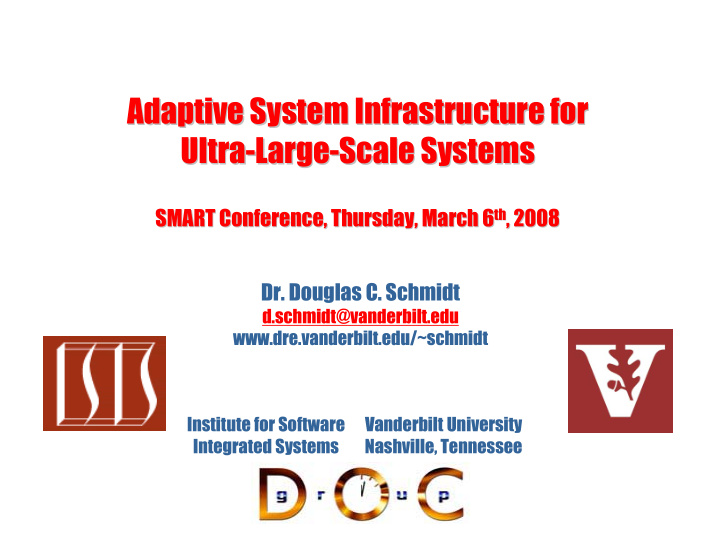



Adaptive System Infrastructure for Adaptive System Infrastructure for Ultra- -Large Large- -Scale Systems Scale Systems Ultra SMART Conference, Thursday, March 6 th , 2008 SMART Conference, Thursday, March 6 th , 2008 Dr. Douglas C. Schmidt d.schmidt@vanderbilt.edu www.dre.vanderbilt.edu/~schmidt Institute for Software Vanderbilt University Integrated Systems Nashville, Tennessee
Past R&D Successes: Platform-centric Systems From this design paradigm… Air Legacy systems are designed to be: Frame Nav WTS • Stovepiped AP FLIR • Proprietary GPS IFF • Tightly-coupled, brittle, & non-adaptive • Expensive to develop & evolve • Vulnerable Cyclic Exec Problem: Small changes can (& do) break nearly anything & everything
Past R&D Successes: Platform-centric Systems …and this operation paradigm… Real-time quality of service (QoS) Utility “Curve” requirements for platform-centric systems: • Ensure end-to-end QoS, e.g., Utility • Minimize latency, jitter, & footprint “Broken” “Works” • Bound priority inversions • Allocate & manage resources statically Resources “Harder” Requirements Problem: Lack of any resource can (& do) break nearly anything & everything
Past R&D Successes: Network-centric Systems …to this design paradigm… Today’s leading-edge systems are designed Air AP Nav WTS to be: Frame • Layered, componentized, & service- oriented Event Replication Channel Service • More standard & COTS • Robust to expected failures & adaptive for GPS IFF FLIR non-critical tasks Object Request Broker • Less expensive to evolve & retarget
Past R&D Successes: Network-centric Systems …and this operational paradigm… D’ A B C D E F G H I J K L Pub/Sub Information Backbone M N O P Q R S T Y Z • Loosely coupled services
Past R&D Successes: Network-centric Systems …and this operational paradigm… Desired Utility Curve “Working Utility Range” Resources “Softer” Requirements Problem: Network-centricity is an afterthought in today’s systems
System Infrastructure Demands in ULS Systems Key challenges in the problem space •Network-centric, dynamic, ultra-large- scale “systems of systems” •Stringent simultaneous quality of service (QoS) demands •Highly diverse & complex problem domains Key challenges in the solution space •Enormous accidental & inherent complexities •Continuous evolution & change •Highly heterogeneous platform, language, & tool environments Conventional technologies ill-suited to meet ULS system infrastructure demands
Promising R&D Areas for Adaptive ULS System Infrastructure • Decentralized Production Management Multi-organization teams • View-Based Evolution • Evolutionary Configuration & Deployment • In Situ Control & Adaptation
Promising R&D Areas for Adaptive ULS System Infrastructure • Decentralized Production Management Multi-organization teams • View-Based Evolution • Evolutionary Configuration & Deployment • In Situ Control & Adaptation
Evolutionary Configuration & Deployment Goals • Develop theory & concepts for ULS system configuration & deployment to distribute, customize, & install software components dependably & securely: • Despite an evolving mixture of proven & unproven components • Despite the existence of different versions of components in various deployment configurations • While providing the ability to rollback to proven configurations when problems are detected
Evolutionary Configuration & Deployment Promising Research Component Vendors: Supply components Approaches Component Component Component • Models, algorithms, & tools for … Vendor A Vendor B Vendor Z specifying, reasoning about, & modifying ULS system components dependencies to Primary Distribution Primary validate key functional Distribution Servers: add metadata to Primary Server properties define security policies, Distribution Server trust relationships & critical • System execution modeling dependencies, & initiate the update cycle techniques & tools to analyze & optimize system QoS before & Distribution Distribution during software updates Peer Peer Distribution Peer: • Scalable protocols for provide scalable automatically distributing support for ULS distribution software updates dependably Endsystem & securely under hazardous Endsystem operating conditions Endsystems: provide mechanisms to support component update lifecycle (download, verify, activate, monitor, fallback, report etc.)
In Situ Control & Adaptation Goals • Develop theories, algorithms, & services that allow ULS systems to • Monitor the activity of system elements & their environments • Perform self-testing to detect deviations in expected behavior & performance & automatically recover from them • e.g., by reconfiguring component behavior & configurations while the system is operating • Protect the system from damage when patches & updates are installed, as well as from attacks perpetrated against them during operation Protect Detect React Attacks
In Situ Control & Adaptation Promising Research Approaches • Control-theoretic techniques that handle rapidly changing demands & resource-availability profiles & configure these mechanisms with service policies tuned for different operating modes • Scalable techniques for developing controllers that adapt ULS systems under a wide range of conditions • Certification techniques & processes that can ensure adaptive systems only operate within safe, correct, & stable configurations QoS QoS Requested QoS Control Control Control Control Control Algorithm Control Algorithm Algorithm Algorithm Algorithm Algorithm Measured QoS Control Workload & Vars. Workload & Workload & Replicas Replicas Replicas Connections & Connections & Connections & priority bands priority bands priority bands CPU & memory CPU & memory CPU & memory Ship-wide QoS Doctrine Network latency Network latency Network latency & bandwidth & bandwidth & Readiness Display & bandwidth
Concluding Remarks • The emergence of ULS systems requires significant innovations & advances in adaptive system infrastructure • Not all technologies will provide the precision we’re accustomed to in legacy small-scale systems • Breakthroughs in computing technology & related disciplines needed to address ULS system infrastructure challenges • Initial groundwork layed in various R&D programs Much more research needed on adaptive infrastructure for ULS systems
Recommend
More recommend